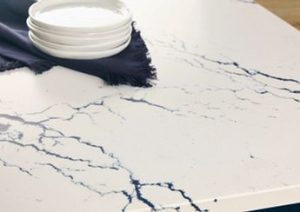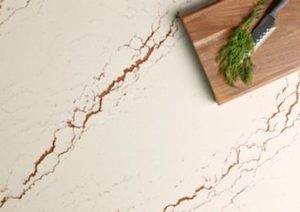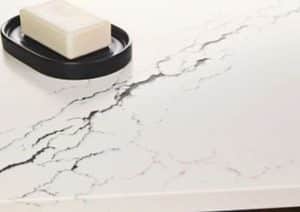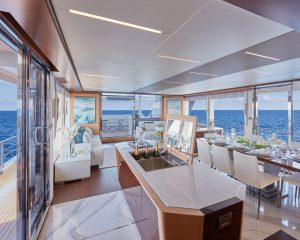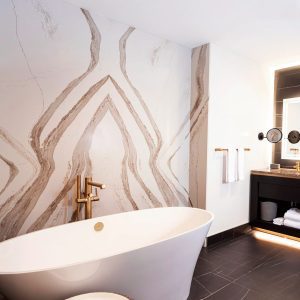On our latest podcast episode guest Summer Kath, Executive Vice President of Design at Cambria® joins us to discuss quartz surfaces. She has been with Cambria for 20 years and is the creative force behind all-new design launches at Cambria. Summer is responsible for translating consumers’ existing and unmet wants and needs into product development, combining her trend-spotting, keen eye with the art and science behind quartz.
Let’s start with the basics, what is quartz?
Well, let’s be more specific quartz surfaces. Quartz is a mineral and it’s mined, and it is one of the most abundant and strong minerals on this planet. So, if you think about when you buy stone, that’s quarried out of the earth. Some stones have quartz in them. And the stones that have a higher percentage of quartz are the stronger stones. We are made from a recombined process using 93% quartz mine from a quartz mine in North America that we own, brought to Minnesota. And that court is combined with a little bit of binder and pigment for the color. And we create Cambria the slab, which is what makes it so high performing. It’s the durability of that quartz.
How is a different from quartzite?
So, quartz surfaces are produced or manufactured to create this superpower high-performing stone. Quartzite is a quarried stone where their mines have all sorts of different types of stones and quartzite just happens to be one where there’s a higher concentration of the mineral.
Should I be using granite or should I be installing quartz counters? Is this a good alternative and why to a natural stone?
I mean, I will be the first to say as the designer of Cambria that natural quarried stone whether it be granite marble, quartzite, onyx. They’re beautiful and there are projects that I think are wonderful and actually can coordinate with Cambria. But I think today we have busy households, especially in the kitchen quartz it’s really come a long way in the aesthetic and the design, cause we’re all looking for something absolutely beautiful that we will love forever.
So now quartz has been created and at Cambia, we like to feel like we kind of led the way and everybody’s coming along for the ride, real beauty in our products. When you install a Cambria quartz, you don’t have to worry about it. If you’re thinking about granite, you know, every piece of you really don’t know the problems you may have in the future, because it was made by mother nature, which is what creates that beauty. But also, you don’t know where you might have problems with it, etching or staying. Certainly, you could seal it. If you want to put chemicals on your countertops. I don’t want to do that. And so, putting quartz counters in your house just ensures that you don’t have to worry. You have a warranty if ever there is an issue with installation fabrication and its everlasting beauty.
How is Cambria different than other quartz manufacturers?
You know, when we first started 20 years ago there were really only three brands and today the market is flooded with off-brands that you don’t even know where they’re manufactured abroad. You don’t know how they got here or any of their kind of employee situations.
We can tell you that when you’re buying Cambria, it is of the highest quality because we own the quartz mine. So, we know where our quartz comes from and we can pick the highest quartz. We produce it here in America, where everybody gets a fair wage are paid very well by veterans. The average tenure of our employees at the manufacturing facility is nine years. So, it is being produced by employees that are taken care of and know what they’re doing. And then quality is everything. So not just in our raw materials in the quartz, but everything from producing the slabs to making sure that they have the perfect sheen, that there are no imperfections.
I mean, every slab that leaves our plant is going to potentially be somebody’s kitchen, somebody’s fireplace surround. And we need to make sure that it absolutely shines. And so, there’s an absolute guarantee that when you like Cambria, that there’s so much care taken to make sure that you have the highest quality product and then the innovation portion of it.
We have a wide selection. We have something for everybody around the country, for sure. And the reason we are here in this situation is that the family, you know, being a family-owned business, we’re not beholden to shareholders and all of that. We invest heavily in our technology and innovation.
So being the first to have a Britannica™, being the first to have a Skara Brae™ and a Portrush™, our wonderful selling designs that nobody has anything that can touch. That’s only happening because of the investments made in our technology to actually invent equipment, to make designs like that, that nobody’s done before.
If you think about the combination of all of that together, there’s not one quartz company that can say they have every single one of those covered. And the end result is as a consumer. When I see Cambria, I don’t have to worry. I know that everything’s going to be taken care of. I know that’s the highest quality court’s product.
And all I have to do is, you know, make the hard decision of which one.
Can you speak a bit about the design process and how you arrive at the colors and movement?
You know, I will tell you that the marble looks, the whites are really popular, but 20 years ago, granite was luxury because marble wasn’t really on the scene. It wasn’t affordable yet. And from the very beginning, I can tell you what I was brought into, and I’m not an interior designer by trade. I’m a marketer and somebody who cut their teeth on design at Cambria. And in the beginning, it was really studying the trends. Obviously back then, it was a lot of black granites. It was a lot of tan walls. And we had a lot of old cabinets you’re dealing with and dark cherry cabinets. For us, in the beginning, our pallet was so in its infancy and the sky’s the limit of where we go, where do we want to go?
The priority then was to go after the luxury client who loves granite today, but we need to convince them that we are a better product. And we need to have an array of tones that live within the kitchen that they love today, and then we matured. In the very beginning, some of our beginning designs, Victoria™, Nottingham™ those all lived within those interiors and they were a new technology that actually had random variation.
That was never before seeing quartz back then, if you remember, 20 years ago, quartz was kind of that kitty litter, very splotchy in a variety of tones. Every tone possible in that formation. And so, we really broke out of that and kind of blazed the trails for quartz. Our competitors started taking notice that, wow, how can we do this? And we just kept going. We didn’t look back.
And continue to look at the trends of where’s the puck going and where is it today. We want to make sure that we offer what people want today, because we know we’re going to sell a lot of it, but we have to be ahead of the curve in the future.
Myself as a designer, I’ve really evolved. You know my technique as far as not only paying attention to North America, but I started going to the European shows Milan and Paris and London and seeing kind of what’s coming in 2016, I went to Salone Del Mobile in Milan, and I walked in and this is when we’re right smack in the white kitchen era in 2016, and everything was black and opulent Navy. And I was like, holy smokes, and it’s influenced me in such a big way. There are a lot of designs that I literally started to work on that are selling really well today. So, stay ahead.
We’re really looking at what’s the market going to bear and where do we want to push the envelope and be the first to do it? We have a whole strategy for that, but also, we have different looks and platforms. It’s pretty obvious from the Marble collection to the Waterstone collection. Technology development and what we can do in a platform, but also how do we fill out the bouquet in beautiful tones that we want to install in our kitchen?
I will layer it on a dream board of how they’re all going to layer. We have a whole sophisticated system that actually tracks every design and every single process. I enter a design into the system as a dream board. Then we start to create iterations of tiles, which are what we tweak and get to a moment of, yes, this is the design. Let’s go make it in the plant in a full slab and go really spend the money.
How often does Cambria release new designs?
There is no rhythm because we reserve the right to launch as many designs that we feel are ready and are amazing. You know, if you kind of set the bar and say it has to be 50 a year you might miss out on spending more time on one design that has more potential.
We have committed to and have completed four new launches in 2021. In fact, today was our fourth and final launch. We launched four new designs today, so 16 this year last year in 2020, we actually launched 34.
November 2021 New Designs
Stormy-blue veins with subtle metallic flares fracture a cool white canvas with pulsating intensity. Debossing throughout the veining contrasts with the smoothness of the background, giving the design a gently textured composition and beautifully organic quality.
Molten gold veins fracture a cool white canvas with pulsating intensity. Debossing throughout the veining contrasts with the smoothness of the background, giving the design a gently textured composition and beautifully organic quality.
Deep bronze veins with rosy undertones fracture a cool white canvas with pulsating intensity. Debossing throughout the veining contrasts with the smoothness of the background, giving the design a gently textured composition and beautifully organic quality.
Soft charcoal veins scattered with hints of silver fracture a cool white canvas with pulsating intensity. Debossing throughout the veining contrasts with the smoothness of the background, giving the design a gently textured composition and beautifully organic quality.
Where do you see these design trends heading feeling into 2022? Do you have any vision as to what you think will change?
I think in our world, especially in countertops, what I’ve seen in the last 20 years is the trends are very slow-changing. And a big part of that is because we’re a pretty visible product. We’re a pretty permanent product and it’s a good investment. When you’re looking at your countertops, you want something that you feel is timeless.
If you see new things coming on the marketplace, it’s hard to make that leap. And so, we have to be very strategic when we are going to put out designs that we know are for the future. It’s going to take a while. And I think what I’m seeing is certainly white countertops are not going away, but what I’m seeing trend is warmer white.
I think that’s going to continue next year, warming up of the room. That’s why we’re seeing tones like burgundy and terracotta and clay. Really come in.
And so, these four designs, we just launched their family and they’re all white background, but the veining has an indentation. So, it has a texture and they’re metallic. One of them is actually that gold metallic that in a vein is different.
Can you talk a little bit about the new six-millimeter slab, what drove that new size?
I would say in the last 10 years have started to really focus on also commercial. Obviously that there’s so much opportunity for surfaces, especially something low maintenance. We have some divisions that go after different sectors and one is luxury transportation. I think what really prompted it is the big opportunities are on yachts, having something that is so light. Or also in elevators, private jets, or RVs. There is spillover, on the residential side, with the opportunity for all the surrounds in cabinets or hood cladding.
I recently saw something new with Cambria called bookmatching, what is that?
It is split in half. We call it bookmatch or butterfly. Essentially what we do is we literally slice into the slab and open it up and it’s a mirror image. You’re right. It’s available in 16 of our designs that have the heavy veining and it’s just beautiful.
Listen to the podcast for all the details and more information. Look for future episodes on Apple, Spotify, Google, or Stitcher. We’ll also make sure to share each episode right here on our blog.

